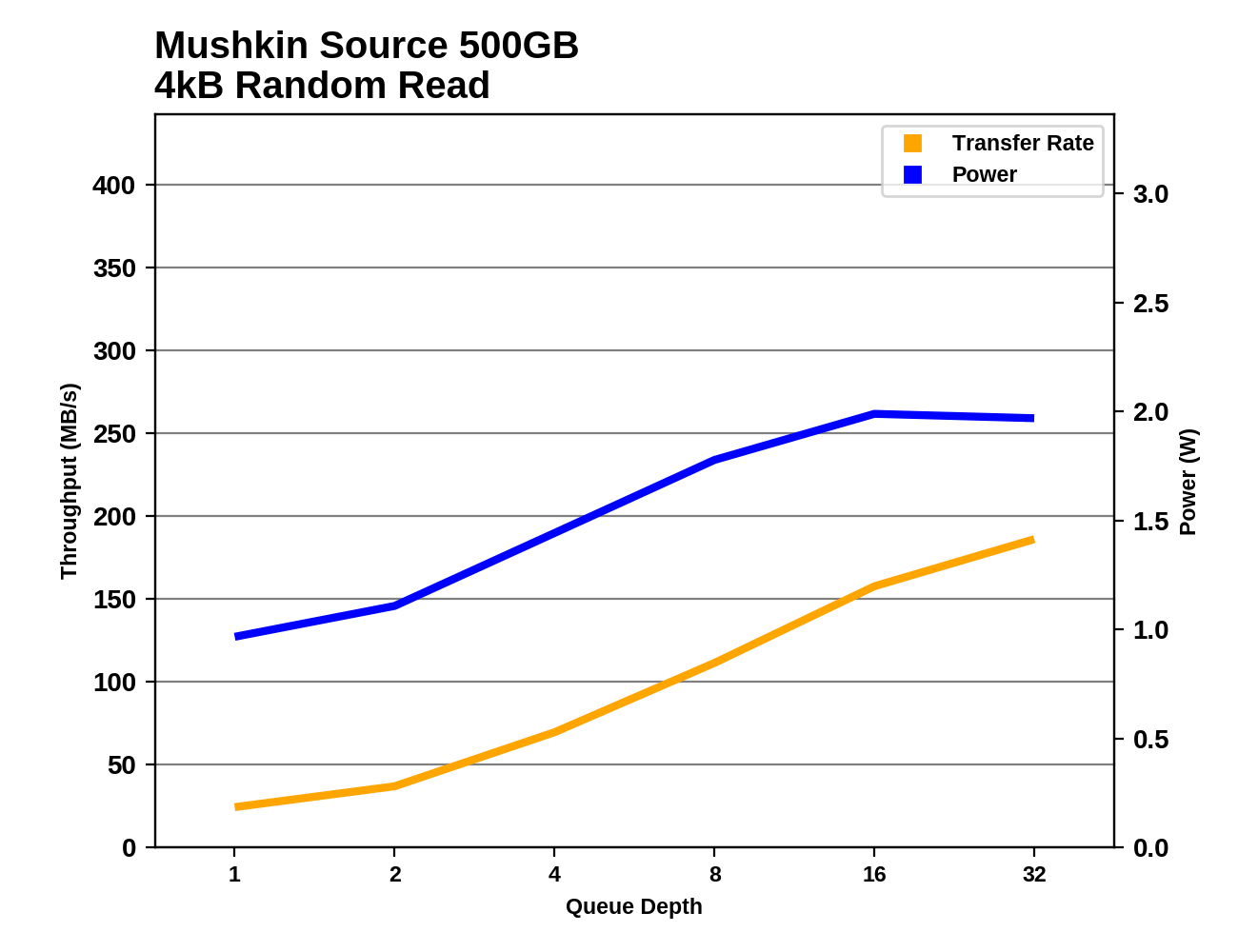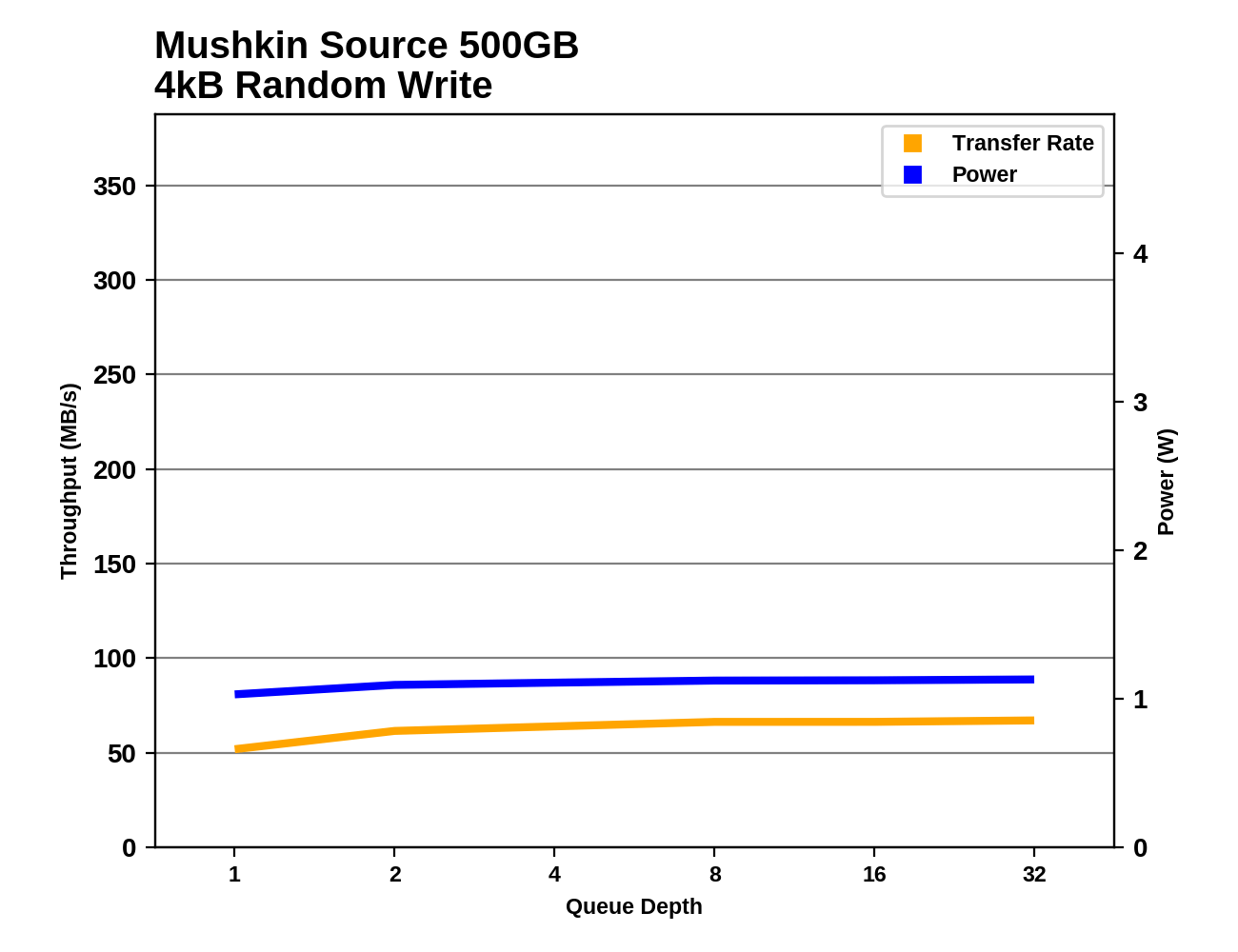The Mushkin Source 500GB SATA SSD Review: A Value Proposition For An Everyday PC
by Billy Tallis on November 21, 2018 10:00 AM ESTRandom Read Performance
Our first test of random read performance uses very short bursts of operations issued one at a time with no queuing. The drives are given enough idle time between bursts to yield an overall duty cycle of 20%, so thermal throttling is impossible. Each burst consists of a total of 32MB of 4kB random reads, from a 16GB span of the disk. The total data read is 1GB.

The burst random read performance from the Mushkin Source is low, as expected from a DRAMless SSD. The Crucial MX500 manages almost twice the performance with the same NAND flash. Compared to other DRAMless SSDs, the Toshiba TR200 has the clear lead over the Mushkin Source, but the Source is an improvement over the HP S700's older 32L TLC.
Our sustained random read performance is similar to the random read test from our 2015 test suite: queue depths from 1 to 32 are tested, and the average performance and power efficiency across QD1, QD2 and QD4 are reported as the primary scores. Each queue depth is tested for one minute or 32GB of data transferred, whichever is shorter. After each queue depth is tested, the drive is given up to one minute to cool off so that the higher queue depths are unlikely to be affected by accumulated heat build-up. The individual read operations are again 4kB, and cover a 64GB span of the drive.

On the longer random read test that brings in some slightly higher queue depths, the Mushkin Source pulls ahead of the other DRAMless SSDs but is still unable to match the mainstream SATA SSDs with full-size DRAM caches.
 |
|||||||||
| Power Efficiency in MB/s/W | Average Power in W | ||||||||
The Mushkin Source uses substantially more power during the random read test than the other two DRAMless SSDs, so it has one of the lowest efficiency scores while the Toshiba TR200 manages a slightly above-average score.
 |
|||||||||
The random read performance of the Mushkin Source does scale with increasing queue depth (especially past QD2), but the mainstream SATA SSDs greatly outpace it and several end up with almost twice the performance at high queue depths.
Comparing the Mushkin Source against all the other SATA SSDs that have completed this test, it is clear that the Source doesn't come close to reaching the limits of the SATA interface, and its power consumption at high queue depths is rather high for the performance it enables.
Random Write Performance
Our test of random write burst performance is structured similarly to the random read burst test, but each burst is only 4MB and the total test length is 128MB. The 4kB random write operations are distributed over a 16GB span of the drive, and the operations are issued one at a time with no queuing.

The burst random write performance of the Mushkin Source is a bit on the slow side, but the DRAMless SSDs don't stand out as extreme outliers thanks to their reasonably quick SLC write caches.
As with the sustained random read test, our sustained 4kB random write test runs for up to one minute or 32GB per queue depth, covering a 64GB span of the drive and giving the drive up to 1 minute of idle time between queue depths to allow for write caches to be flushed and for the drive to cool down.

On the longer random write test, the difficulty of managing an overflowing SLC cache on a DRAMless drive is readily apparent, and the Mushkin Source suffers more than the other two DRAMless SSDs. The mainstream SATA SSDs are 3-4 times faster than the Source.
 |
|||||||||
| Power Efficiency in MB/s/W | Average Power in W | ||||||||
The Mushkin Source and other DRAMless SSDs do use significantly less power than the mainstream SATA SSDs on the random write test, but the savings are nowhere near large enough to make up for the huge performance deficit. The Source is both slower and more power-hungry than the other DRAMless SSDs, so it comes in last place for efficiency.
 |
|||||||||
The random write performance of the Mushkin Source does not improve appreciably with increasing performance, because each phase of this test writes more than enough data to exhaust the SLC cache. The Toshiba TR200 DRAMless SSD does manage a significant increase from QD1 to QD8, but even so it offers less than half the performance of a good mainstream drive.
Plotted against all the other SATA SSDs that have completed this test, it is clear that the Mushkin Source is one of the slowest, and other drives have offered much higher performance within a lower power budget.












30 Comments
View All Comments
Amandtec - Wednesday, November 21, 2018 - link
On PC Partpicker you can chose a chinese brand 500GB for about $42 vs about $72 for the Samnsung. So it is a little more than 10% difference.piroroadkill - Wednesday, November 28, 2018 - link
So $30 to not lose your data? Sounds like a good deal.piroroadkill - Wednesday, November 28, 2018 - link
Yeah, the SSD market is filled with wrong decisions.I just basically go for a TLC Samsung drive that fits the budget, and pretty much ignore everything else.
kmmatney - Wednesday, November 21, 2018 - link
Microcenter has their Inland 480GB SSD for $59.99. I have bought about 10 of the Inland SSDs so far, in various sizes (mostly the 240GB for $33). They have all worked great for normal everyday workloads, and most of these were installed as boot drives. The Microcenter SSDs are also DRAMless - maybe they don't bench as well, but they still have that SSD feel to them, and perform well doing normal tasks.fmcjw - Wednesday, November 21, 2018 - link
Well written article, thorough but not verbose, thank you Billy! Reminds me of Anand and Bruce...Recently bought a 480GB no name SSD that uses the same controller and NAND for only around $40 (singles day deal here in my home market in Taiwan). It has similar characteristics to the Source as you described (full disk SLC cache, etc.), but returned it because it makes a loud/hi-freq electrical noise when written to and read from. Forums here say that the 2258XT (or its ASMedia licensed copy) can overheat under heavy use and die before the NAND expires, so thermal design and general electrical design/component quality is critical. I'm not sure if you examined these design flaws or if you plan to add them to future routines? Granted it's probably specific to each production batch, but might be worth checking on each drive that you come across if it's not too much work.
I understand you include links to Destroyer methodology, but it will be helpful to briefly describe what constitutes a "full" and "empty" drive in brief, for faster reading without having to click through.
Also, a bit curious about SLC caching, its different types and what that means for real world usage. I imagine frequently accessed operating system files should be kept in SLC, and not moved into TLC, but unsure if any firmware is so smart about this. If if keeps moving files without discretion it will also be bad for write amplification.
Thanks again!
Billy Tallis - Thursday, November 22, 2018 - link
I hadn't heard about 2258XT controllers dying or overheating. It hasn't happened to any of my drive samples yet. I also don't recall hearing coil whine coming off the Source, though I have heard it from a few SSDs during testing.For the full-drive ATSB Heavy and Light test runs, the drive is filled with sequential writes of random data to every single sector, then given a five minute break to cool off and flush caches before the test begins.
TLC drives generally treat the SLC cache as a write buffer, and will aggressively migrate data from SLC to TLC blocks during idle times. The QLC drives on the market so far are much more willing to keep data in SLC until it is necessary to compact it into QLC blocks, so the SLC cache helps with write and read performance. I'm not aware of any drives that move frequently-read data from TLC/QLC blocks back to SLC to optimize read performance.
gglaw - Saturday, November 24, 2018 - link
Billy - I don't get the indications of when the performance falls off after the SLC cache is full. The graphs indicate it drops off after around 170GB of data is written. How is this possible on a budget TLC drive? Does this mean there is 170GB of SLC cache on this drive? That couldn't be true for a budget DRAM-Less drive since it would add way much to the cost of the drive that the market it is targetting would not need. No one buying this type of drive would be doing workloads to push it past this threshold so it makes 0 business sense to equip it in this way. Basically no performance sense either since this large of a cache will never be used by customers buying bottom barrel drives.I'm probably reading it entirely wrong - do you have a clearer explanation of what is going on?
Billy Tallis - Saturday, November 24, 2018 - link
The full-drive sequential write test is essentially a best-case scenario that illustrates the maximum possible SLC cache size for drives with variable-size caches. The drive starts out empty so the SLC cache is at its largest size, and sequential writes are easier for the controller to handle than random writes.It looks like the Mushkin Source more or less runs all of its NAND as SLC initially, which is why it takes so long for the write speed to drop. It's also possible that the write throughput from the controller to the NAND is significantly faster than the SATA link, so the drive might have some slack to start folding data from SLC to TLC blocks in the background before the cache fills up.
The other SM2258 drives appear to start folding before the cache is full, but with the slower 32L TLC that did have an impact on the write speed.
At some point I may expand the SLC cache test to better show the range of behaviors for variable-size caches.
WasHopingForAnHonestReview - Thursday, November 22, 2018 - link
Great review, thank you.excelle08 - Thursday, November 22, 2018 - link
This could benefit for non-power user consumers who just want faster booting or everyday software loading. However the price is not reasonable for such a piece of junk - Intel's 660p already sucks, let alone this unknown brand who is likely to use "who knows" black/white flash chips, plus without DRAM cache. If I only have $30 budget for storage I'd rather go to ebay and search for a used older SATA2 MLC stuff(such as Intel X-25M) than this 120G QLC drive.